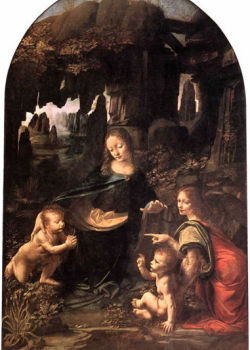Leonardo's Geology
Leonardo da Vinci was a consummate observer of nature. His scientific curiosity led him to capture natural objects not only beautifully, but accurately as well. His sketches and drawings serve as a record of the geological formations he saw in his travels. Most of his life was spent in Italy, traveling between Florence and Rome, but it was in 1482, when he went to Milan to work for Ludovico Sforza, that he became fascinated with Alpine geology. He spent considerable time in the mountains observing the structure of rock formations, the presence of fossils imbedded in stone and the natural characteristics of water and air. He memorialized his observations in his note book, now known as the Codex Leicester, which details his thoughts and observations on geology, hydrology and the effects of water and air on the earth. He revealed his observations in his paintings and drawings by precisely depicting geologic formations which, at the time had not been named, but which are readily identifiable to a modern geologist.
Left photo: Virgin of the Rocks, Louvre, 1483-86, Leonardo da Vinci

